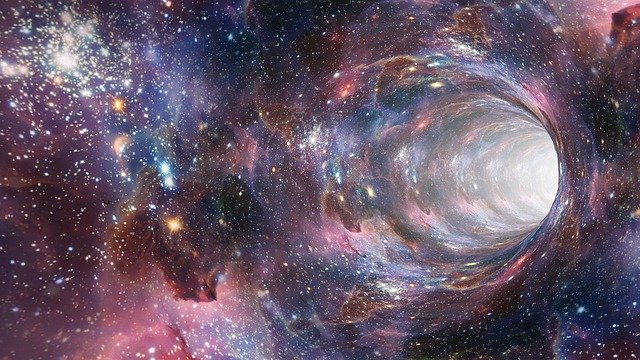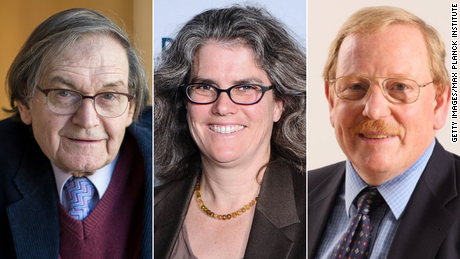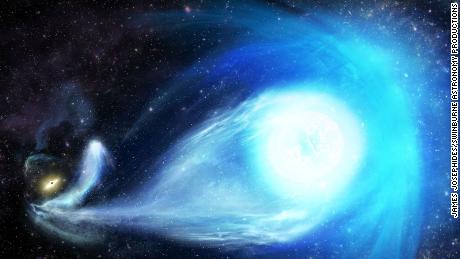Sign up for CNN’s Wonder Theory science newsletter. Explore the universe with news on fascinating discoveries, scientific advancements and more.
It’s the first direct observation confirming the presence of the black hole, known as Sagittarius A*, as the beating heart of the Milky Way.
Black holes don’t emit light, but the image shows the shadow of the black hole surrounded by a bright ring, which is light bent by the gravity of the black hole. Astronomers said the black hole is 4 million times more massive than our sun.
“For decades, astronomers have wondered what lies at the heart of our galaxy, pulling stars into tight orbits through its immense gravity,” Michael Johnson, astrophysicist at the Center for Astrophysics | Harvard & Smithsonian, said in a statement.
“With the (Event Horizon Telescope or EHT) image, we have zoomed in a thousand times closer than these orbits, where the gravity grows a million times stronger. At this close range, the black hole accelerates matter to close to the speed of light and bends the paths of photons in the warped (space-time).”
The black hole is about 27,000 light-years away from Earth. Our solar system is located in one of the spiral arms of the Milky Way galaxy, which is why we’re so distant from the galactic center. If we could see this in our night sky, the black hole would appear to be the same size as a doughnut sitting on the moon.
“We were stunned by how well the size of the ring agreed with predictions from Einstein’s Theory of General Relativity,” said EHT project scientist Geoffrey Bower from the Institute of Astronomy and Astrophysics, Academia Sinica, Taipei, in a statement.
“These unprecedented observations have greatly improved our understanding of what happens at the very (center) of our galaxy, and offer new insights on how these giant black holes interact with their surroundings.”
The results of this groundbreaking discovery were published Thursday in a special issue of The Astrophysical Journal Letters.
Searching for the black hole
It has taken five years for astronomers to capture and confirm this image and discovery. Previously, scientists observed stars orbiting some invisible, massive object at the galactic center.
The 2020 Nobel Prize in physics was awarded to scientists Roger Penrose, Reinhard Genzel and Andrea Ghez for their discoveries about black holes, including evidence shared by Ghez and Genzel about the mass of the object at the center of the Milky Way.
“We now see that the black hole is swallowing the nearby gas and light, pulling them into a bottomless pit,” Ramesh Narayan, a theoretical astrophysicist at the Center for Astrophysics | Harvard & Smithsonian, said in a statement. “This image confirms decades of theoretical work to understand how black holes eat.”
The discovery was made possible by more than 300 researchers from 80 institutions working with a network of eight different radio telescopes around the globe that make up the Event Horizon Telescope.
The telescope is named after the “event horizon,” the point at which no light can escape from a black hole. This global telescope network essentially forms a single “Earth-size” virtual telescope when all eight are linked and observing in tandem.
It’s the second image ever captured of a black hole, with the first being the EHT’s achievement of imaging M87* at the heart of the distant Messier 87 galaxy, located 55 million light-years away, in 2019.
While the two images look similar, Sagittarius A* is more than 1,000 times smaller than M87*.
“We have two completely different types of galaxies and two very different black hole masses, but close to the edge of these black holes they look amazingly similar,” said Sera Markoff, cochair of the EHT Science Council and a professor of theoretical astrophysics at the University of Amsterdam, in a statement.
“This tells us that (Einstein’s theory of) General Relativity governs these objects up close, and any differences we see further away must be due to differences in the material that surrounds the black holes.”
Capturing an impossible image
Although the Milky Way’s black hole is closer to Earth, it was much harder to image.
“The gas in the vicinity of the black holes moves at the same speed — nearly as fast as light — around both Sgr A* and M87*,” EHT scientist Chi-kwan Chan at the Steward Observatory and Department of Astronomy and the Data Science Institute of the University of Arizona, said in a statement.
“But where gas takes days to weeks to orbit the larger M87*, in the much smaller Sgr A* it completes an orbit in mere minutes. This means the brightness and pattern of the gas around Sgr A* was changing rapidly as the EHT Collaboration was observing it — a bit like trying to take a clear picture of a puppy quickly chasing its tail.”
The global network of astronomers had to develop new tools to allow for the quick movement of gas around Sagittarius A*. The resulting image is an average of different ones taken by the team. Taking the Sagittarius A* image was like capturing a photo of a grain of salt in New York City using a camera in Los Angeles, according to California Institute of Technology researchers.
“This image from the Event Horizon Telescope required more than just snapping a picture from telescopes on high mountaintops. It is the product of both technically challenging telescope observations and innovative computational algorithms,” Katherine Bouman, Rosenberg scholar and assistant professor of computing and mathematical sciences, electrical engineering and astronomy at the Caltech, said during a press conference.
Bouman also worked on capturing the M87* image shared in 2019. Despite the fact that the Sagittarius A* image may seem blurry, “it’s one of the sharpest images ever made,” Bouman said.
Each telescope was pushed to its limit, which is called a diffraction limit, or the maximum fine features that it can see.
“And that’s basically the level that we’re seeing here,” Johnson said at the press conference. “It’s fuzzy because to make a sharper image, we need to move our telescopes further apart or go into higher frequencies.”
On the horizon
Having images of two very different black holes will allow astronomers to determine their similarities and differences and better understand how gas behaves around supermassive black holes, which could contribute to the formation and evolution of galaxies. It is believed that black holes exist at the center of most galaxies, acting like an engine that powers them.
Meanwhile, the EHT team is working to expand the telescope network and conduct upgrades that could lead to even more stunning images, and even movies, of black holes in the future.
Capturing a black hole in motion can show how it changes over time and what the gas does as it swirls around a black hole. Bouman and EHT member Antonio Fuentes, who will join Caltech as a postdoctoral researcher in October, are developing methods that will allow them to stitch images of the black hole together to reflect this motion.
This “first direct image of the gentle giant in the center of our galaxy” is just the beginning, said Feryal Özel, member of the EHT Science Council and a professor of astronomy and physics and associate dean for research at the University of Arizona, during the press conference.
“This image is a testament to what we can accomplish, when as a global research community, we bring our brightest minds together to make the seemingly impossible, possible,” National Science Foundation Director Sethuraman Panchanathan said in a statement. “Language, continents and even the galaxy can’t stand in the way of what humanity can accomplish when we come together for the greater good of all.”













